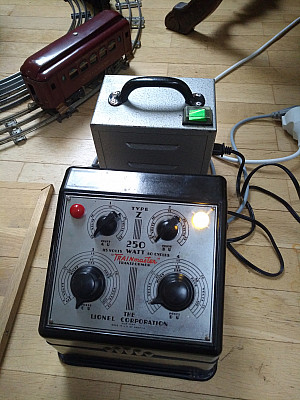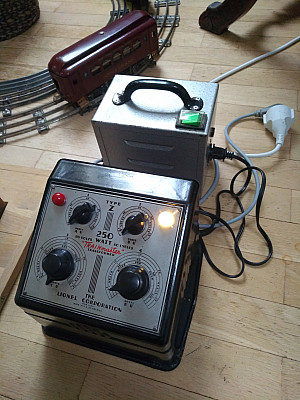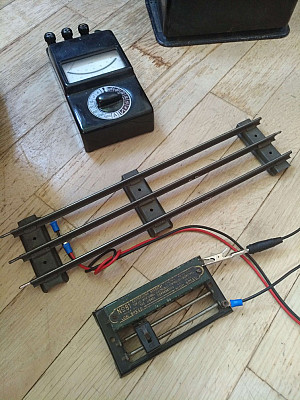My Transformer Setup for Standard Gauge
← Lionel Standard Gauge Betrieb | ● | Lionel Standard Gauge MTH Gleise →
Here is my setup for running Lionel (or American Flyer or Ives) Standard Gauge trains:
I use an original Lionel Z transformer. This was the top of the line transformer for Standard Gauge rated at 250 Watts. To run such an original US transformer, which was designed for the US 110V mains, on the European 220V circuit, I use a 750W step-down transformer of Tramag AG, Fürth. These have a European VDE plug on the input chord and an US style NEMA socket on the output. So you can just plug the Lionel Z into the Tramag.
The Tramag outputs 100 Volt instead of 110V to compensate for the reduced AC frequency of 50 Hz compared to the 60 Hz in the US. For a transformer to operate in the appropriate spec range, the ratio of $\frac{U}{f}$ should stay the same, which means that the inductance of the transformer’s coils will also stay the same. Then the transformer operates at the same conditions for which it was designed reducing thermal losses to a minimum. For example, if the ratio of a transformer in the US is 110V/60Hz = 1.83, then the ratio of the same transformer rises to 110V/50Hz = 2.2 in Europe. For a voltage of 100 Volt the ratio is much closer at 100V/50Hz = 2.
With 100 Volts at 50Hz I measure about 22.5V at the outputs of the Lionel Z transformer. That’s close enough to the nominal rating of 25V in the US. Interestingly, with a 110 Volts converter I also measure 22.5V. So in contrast to the theory the actual voltage does not appear to make any difference. Either 100 Volts or 110 Volts at 50 Hertz yields 22.5 Volts on the outputs of the Lionel Z transformer.
Lamp bulbs for the Lionel Z (or any prewar Standard Gauge Lionel transformer) have a voltage of 7.5V rated at 1.5W. The original part number is #51. This bulb has a BA9S bayonet base to twist it in.
The best replacement available today is an automotive part with the same BA9S base with 6V rated at 1.2W. Do not use bulbs with a higher Watt rating, since they will burn the red resp. green plastic covers. The bulb size that fits under the plastic cover is 9mm x 23mm although this will already fit very tight.
Adding a Lionel #81 rheostat in series to the transformer as depicted above, will complement the setup nicely. The advantage of a rheostat is that the speed of an inductive motor is controlled well, while lamps are not affected that much. As a result they are not dimmed completely when the motor speed is throttled by the rheostat. It is even possible to bring the loco to a halt with the lamps still lit. Of course this is not advised for a prolonged period of time.
The rheostat has a slider which controls the throttled voltage. It also has an on/off switch to start and stop the train at the preselected voltage (see images below). Locomotives with an E-unit will stop and reverse by using the switch.
Rheostats are also handy to reduce speed in a particular track section, for example in a tight curve. For this purpose, the curve is insulated and powered over a separate cable that contains a rheostat in series. Then the rheostat throttles the curve speed by a preselectable ratio.
Overall rheostats are plenty of fun to play with.




